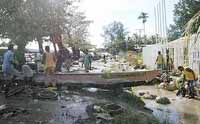Solomon Islands villagers bury their dead, too afraid to return home
An old green trunk served as the coffin for one boy, the other was buried in a casket hammered together from scrap materials pulled from the rubble of this tsunami-shattered village.

Three days after the ground shook and the sea surged at them with terrifying force, residents of Titiana have taken to burying the dead as soon as they find them because of the fear of disease and the awful odor hanging over the beach.
"The smell, the smell," Pita Pikisa said Thursday, grimacing as he worked with other villagers to dig shallow graves in the ground, a mix of sand and hard coral.
Survivors say they have buried several people from the village - they're not sure how many - and expect to inter more. In all, 26 people from the village of a few hundred are missing or dead, Pikisa said.
Once a bustling seaside village with two churches and dozens of wooden shacks, Titiana faced directly onto the Solomon sea and bore the full brunt of Monday's 8.1-magnitude earthquake and tsunami.
The town was flattened in minutes, smashing dozens of wooden houses to splinters and reducing several concrete-block buildings to rubble.
The tattered remains of peoples' belongings lay strewn among the wreckage - sodden clothing, books, old luggage and a photo album bearing pictures of happier days.
Amid the debris, about a dozen villagers dug two shallow graves for the two boys they found nearby earlier Thursday.
They placed the body of a four-year-old boy they called Tekapu into an old green trunk and laid it down between two badly damaged houses. The second boy, who villagers said they could not identify because his head had been partly crushed, was buried in the debris casket.
Pikisa said no one knew where Tekapu or the other boy's parents were, but that villagers would try to find them and tell them of the boys' fate.
Pikisa and others said there are at least 26 people still missing from Titiana, including many children. The smell of decay helps the villagers find the bodies, he said.
Rev. Tikeri Birlata, 35, the village's Uniting Church minister who oversaw Thursday's burial, said officials in nearby Gizo, the largest town in the hard-hit Western Province, have yet to travel the 10 kilometers (6 miles) to Titiana to count the dead and missing.
Authorities say the confirmed death toll from Monday's disaster is about 30, but it could be much higher because of the many remote communities that have no radio contact or where locals are simply not reporting the dead and injured.
Birlata said he was angry at the lack of help in Titiana, and said decisions being taken in the capital, Honiara, were not filtering down to the areas in need.
"They say top-down approach, but there's no top-down here," he said. "When a disaster comes like this, we expect something to come down ... The people are really suffering."
Dozens of Titiana residents are sheltering under tarpaulins in the forested hills about 200 meters (650 feet) above their devastated village.
Subscribe to Pravda.Ru Telegram channel, Facebook, RSS!


